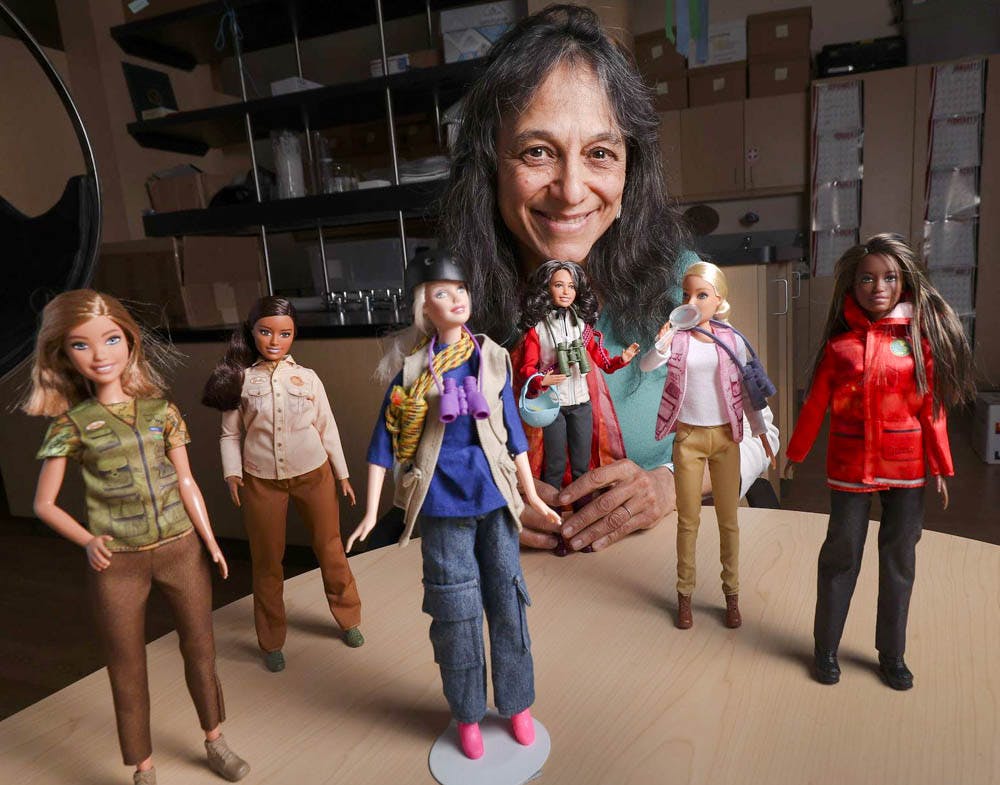In the National Geographic online store, shoppers can find the entomologist Barbie, equipped with a magnifying glass and insect collection kit. She is joined by a marine biologist, who wears a metallic red puffer jacket and rubber boots; a nature photographer; a wildlife conservationist and an astrophysicist, prepared to examine the night sky with her swiveling telescope.
These Barbies, which fall into Mattel’s collection of career dolls, were developed in collaboration with National Geographic and University alum Nalini Nadkarni ’76 honorary PhD ’14 beginning in 2018, and launched last year.
Nadkarni is a forest ecologist who has dedicated her time to educating the public about scientific issues, from deforestation to climate change. To increase public awareness of these environmental concerns, she began creating “Treetop Barbies” from secondhand dolls in 2003. She collaborated with volunteers to craft ecologist outfits and sold the dolls on her personal website, hoping the Barbies might inspire children to consider careers in science. She reached out to Mattel about designing a collection of scientist Barbies and was originally turned down.
But when National Geographic partnered with Mattel to create a line of career Barbies inspired by Nadkarni’s Treetop Barbie, she was asked to advise on the project.
“I think it’s important that young girls get inspired to think about themselves as people who could one day study the forest or conserve the forest or protect the forest,” Nadkarni said. “Every little girl I know loves Barbie. … Maybe Barbie could be a sort of ambassador to these young girls and get them excited about forest conservation.”
Atmospheric chemist and Associate Professor of Earth, Environmental and Planetary Sciences Meredith Hastings also believes the Barbies will be useful in educating girls on the variety of careers available to them. Hastings is the co-founder and president of the Earth Science Women’s Network, an organization that hosts professional development workshops and provides peer mentoring for women in STEM. Hastings created the ESWN as a young scientist.“We didn’t feel we had any female role models in our institutions,” Hastings said, noting that the career Barbie “opens up (that) possibility.”
“I do really appreciate that these (Barbies) are out there to broaden perceptions of what a scientist looks like,” said Rebecca Kartzinel, assistant professor of ecology and evolutionary biology, referring to the diversity within the career Barbie collection, which appeals to girls with a wide variety of interests and backgrounds. The dolls “highlight that science as a career can mean a lot of different things and that it should be accessible to anyone who is interested.”
The Barbies exhibit another way that Mattel has sought to represent diversity in its products. Alongside a wide range of career dolls, including a judge, political candidate and news anchor, the company announced a gender-neutral doll in September 2019. But Nadkarni notes that it is not Mattel, a “mainstream corporation,” that has changed. “It’s that society has changed.”
“There’s been a real shift just in the last 15 years, that there’s sort of a market for dolls that would encourage young girls to have scientific careers. I think that’s really wonderful. I think that’s splendid,” she said.
Now, Nadkarni wishes to take the project even further. “My hope for the future is not only that girls would just play with these Barbies, but also that they would have information that goes along with these dolls … like a website where they (could) have a conversation with a real scientist,” she said. “That would be wonderful and really productive.”





